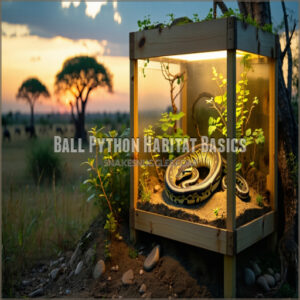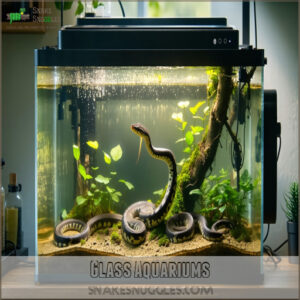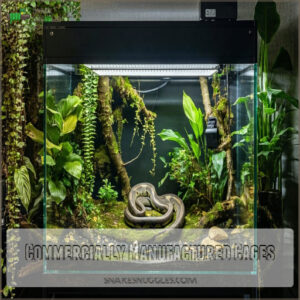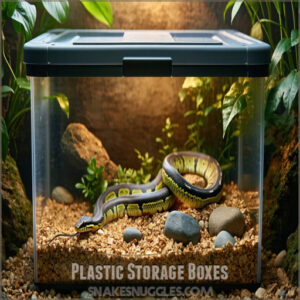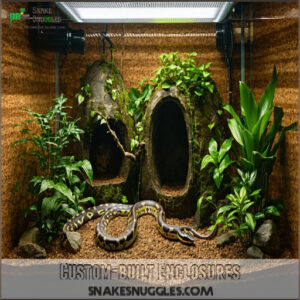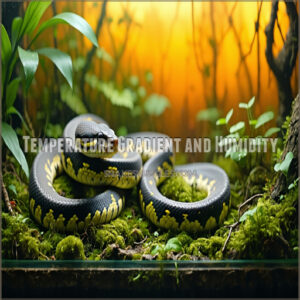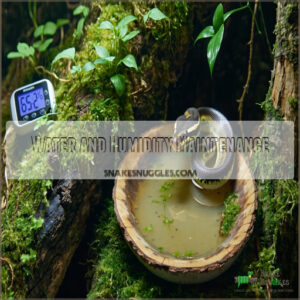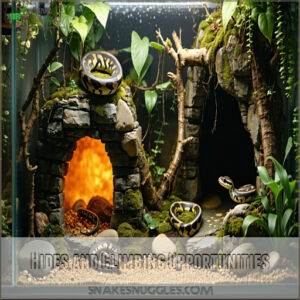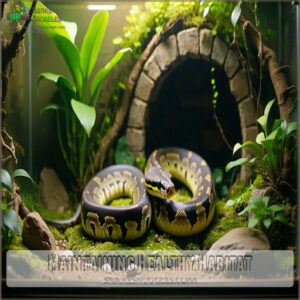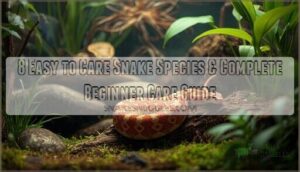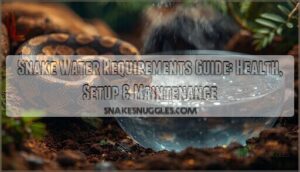This site is supported by our readers. We may earn a commission, at no cost to you, if you purchase through links.
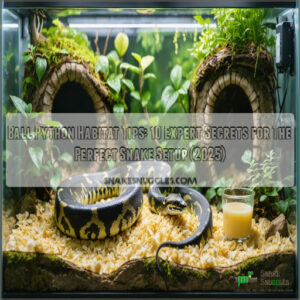
Start with a cozy enclosure—PVC cages or glass tanks work great, as long as they’re secure and well-ventilated.
Maintain a temperature gradient: a toasty 90°F on the warm side and 78-80°F on the cool side.
Humidity should stay at 50-60%, with a bump during shedding. Use substitutes like coconut chips or aspen to lock in moisture.
Add a hide or two for privacy—it’s like a hotel room for your snake. Don’t forget fresh water and a 12-hour light cycle.
Want happier snakes? Stay tuned.
Table Of Contents
- Key Takeaways
- Ball Python Habitat Basics
- Choosing Enclosure Type
- Top 7 Ball Python Substrates
- 1. ReptiSun UVB Fluorescent Light Bulb
- 2. Exo Terra Repti Glo 20 Compact Fluorescent Terrarium Lamp
- 3. Compressed Coconut Chip Reptile Bedding
- 4. aspen snake bedding for reptiles
- 5. Galapagos Natural Sphagnum Moss Terrarium
- 6. Forest Floor Animal Bedding Substrate
- 7. Flukers Repta Vines Pothos Reptile Terrarium Decor
- Setting Up Ideal Environment
- Maintaining Healthy Habitat
- Frequently Asked Questions (FAQs)
- How Often Should I Clean My Ball Python’s Enclosure?
- What is the Best Way to Feed My Ball Python?
- How Often Should I Handle My Ball Python?
- What Plants Are Safe to Have in a Ball Python Enclosure?
- Are Ball Pythons Vocal?
- What is the best habitat for a ball python?
- Can you leave a heat lamp on 24/7 for ball python?
- What do ball pythons like in their tank?
- What not to do with a ball python?
- What plants are safe for ball pythons?
- Conclusion
Key Takeaways
- Maintain a temperature gradient with 90°F on the warm side and 75-78°F on the cool, and keep humidity levels between 50-60%, increasing during shedding.
- Provide at least two hides for security, proper climbing spaces, and a snake-safe substrate like coconut fiber or aspen bedding.
- Use a 12-hour light cycle with subtle lighting for visibility, but avoid UVB unless boosting their natural behaviors.
- Spot-clean daily, deep clean monthly, and monitor temperature and humidity with reliable tools to maintain a healthy environment.
Ball Python Habitat Basics
Creating the perfect habitat for your ball python means understanding their natural lifestyle and needs.
These shy, nocturnal snakes thrive in warm, secure environments that mimic the rodent burrows and grasslands of their Sub-Saharan African home, where they can live as they would in their natural nocturnal lifestyle.
Native Habitat and Behavior
Ball pythons thrive in their natural habitat across Sub-Saharan Africa, particularly in West African savanna ecosystems.
Their behavior reflects their environment:
- They’re nocturnal, active at night to hunt.
- Solitary animals, except during mating season.
- Prefer grassland habitats and rodent burrows to regulate temperature.
- Avoid rainforests and deserts.
- Balance arboreal and terrestrial habits, especially in males.
These West African natives can reach lengths up to six feet, making them a notable species in their natural habitat with distinct habits and unique characteristics.
Sub-Saharan Africa Native
The natural habitat of ball pythons spans Sub-Saharan Africa, including West African regions.
These native species thrive in grassland habitats and savanna ecosystems, avoiding dense rainforests and arid deserts.
Adapted to the African climate, their wild behavior includes sheltering in rodent burrows to regulate temperature.
Understanding this makes sure your ball python terrarium setup mimics their natural habitat effectively, which is crucial for their well-being in Sub-Saharan Africa.
Habitats and Temperature Regulation
Ever wonder why your ball python loves hiding?
In their natural habitats, they stay cozy in rodent burrows to manage heat.
Mimic this by creating a thermal gradient—90°F on the warm side, 78-80°F on the cool.
Use a reliable heating pad, proper ventilation, and humidity levels of 50-60%.
It’s like crafting the ultimate home spa for your snake!
Choosing Enclosure Type
Choosing the right enclosure type is key to maintaining your ball python’s health and comfort.
Whether you go for glass, PVC, or custom-built, each option has pros and cons that impact heat retention, visibility, and ease of cleaning.
Glass Aquariums
A glass aquarium is a solid choice for a ball python enclosure but needs the right setup for success.
- Ventilation Systems: Maintain airflow while keeping humidity levels appropriate.
- Lid Security: Always secure lids to prevent escapes.
- Aquarium Lighting: Use lights sparingly; ball pythons don’t require UVB.
Select a tank that’s at least 36 inches long for adequate space.
For ideal results, consider a Ball Python enclosure that meets specific needs.
Commercially Manufactured Cages
Unlike glass aquariums, commercially manufactured cages are designed with ball pythons in mind.
These PVC enclosures offer excellent heat management, front-opening doors, and sturdy ventilation systems.
With sizes accommodating adult snakes, they simplify your python terrarium setup.
Plus, their secure lids prevent escapes, making them a reliable investment for a reptile cage that blends function with safety.
When selecting a cage, consider the importance of proper ball python cages to guarantee the well-being of your pet.
Plastic Storage Boxes
If you’re looking for a budget-friendly ball python enclosure, plastic storage boxes make a surprisingly good option.
They’re lightweight, affordable, and perfect for a DIY ball python enclosure.
Just make sure to have proper ventilation for humidity control, and use these tips:
- Choose box sizes matching your snake’s growth.
- Add secure lids for safety.
- Monitor temperatures with thermostats.
Custom-built Enclosures
Custom-built enclosures let you design the ultimate ball python habitat setup, balancing creativity with functionality.
Prioritize proper ventilation systems, temperature control, and humidity management to mimic their natural environment.
Use custom materials for durability, and ensure the python terrarium setup includes hides and a temperature gradient.
A well-planned DIY ball python enclosure guarantees comfort, safety, and a healthier snake. By following a custom snake guide, you can create an ideal environment for your pet.
Top 7 Ball Python Substrates
Choosing the right substrate for your ball python isn’t just about looks; it’s key to their health and comfort.
Let’s explore the best options to keep their enclosure safe, clean, and humidity-friendly.
1. ReptiSun UVB Fluorescent Light Bulb
View On Amazon
When discussing UV lighting for ball pythons, the ReptiSun UVB Fluorescent Light Bulb is a game-changer.
While not mandatory, it boosts your python’s immune system, encourages natural behaviors, and mimics sunlight indoors.
Position it 15 inches above the substrate for gentle exposure, and replace it every six months for best performance.
Pairing the bulb with a reflector maximizes effectiveness, ensuring even light distribution.
Though low-maintenance, this bulb enhances your snake’s overall well-being—simple changes like this go a long way to support a healthy environment.
Best For: Reptile enthusiasts looking to improve their reptile’s health and behavior with an easy-to-use UVB light bulb.
- Encourages vitamin D3 synthesis, preventing Metabolic Bone Disease (MBD).
- Boosts appetite, activity, and natural behaviors.
- Secure packaging ensures safe shipping and reliability.
- Limited lifespan, requiring replacement every 6-12 months for optimal UVB output.
- Some reported defective units, such as bent prongs and rattling tubes.
- Minimal heat output may require additional heat sources.
2. Exo Terra Repti Glo 20 Compact Fluorescent Terrarium Lamp
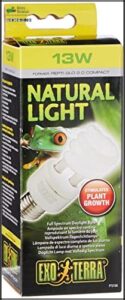
The Exo Terra Repti Glo 20 Compact Fluorescent Lamp is a smart choice for your ball python’s habitat.
While it’s not a heat source, this low-energy lamp provides naturalistic lighting, enhancing your snake’s enclosure look.
Pair it with a timer to maintain a 12-hour light cycle, mimicking day and night, which aligns with their natural behavior.
Its compact design fits most setups, and it even supports terrarium plants.
Just remember, this bulb works for lighting, not basking warmth!
Best For: Terrarium owners seeking energy-efficient lighting for reptiles, amphibians, or plants in compact setups.
- Provides naturalistic lighting for terrarium aesthetics and plant growth.
- Energy-efficient with minimal heat production.
- Compact design fits most enclosures and is easy to install.
- Not a heat source, so it cannot be used for basking.
- Glass construction makes it fragile.
- Unsuitable for reptiles that need high UV exposure.
3. Compressed Coconut Chip Reptile Bedding
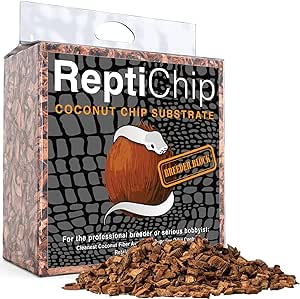
Coconut chip bedding is like a cozy, eco-friendly blanket for your ball python’s home.
It’s 100% organic, absorbs odors, and locks in humidity—essential for maintaining the 50-60% humidity snakes love.
Just add water to expand the compressed block and spread it evenly.
Watch for mold, though, and avoid over-wetting the substrate. Spot clean regularly, and make sure prey items don’t stick to it.
While safe and sustainable, monitor for skin irritation—your python’s comfort comes first. It’s a simple, effective choice, and provides an eco-friendly environment.
Best For: Reptile owners looking for an eco-friendly, humidity-retentive bedding option suitable for tropical habitats.
- Excellent humidity retention for tropical environments.
- Absorbs odors effectively, keeping enclosures fresh.
- Easy to expand and spot clean with added water.
- Potential for mold if over-wet or not mixed properly.
- Can create dust when breaking up the block.
- May cause skin irritation in some reptiles; requires close monitoring.
4. aspen snake bedding for reptiles
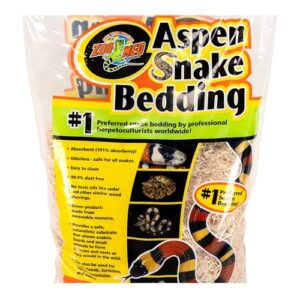
Aspen snake bedding is a herpetoculturist favorite, offering a naturalistic and safe environment.
Its medium-fine texture lets your ball python burrow comfortably, mimicking wild behaviors. It’s non-toxic, hypoallergenic, and 99.9% dust-free, making it perfect for sensitive reptiles.
Absorbent and easy to spot-clean, it also controls odors effectively. Aspen bedding supports healthy humidity levels but avoid overwatering to prevent mold.
Replace it weekly for a clean habitat, and remember, it’s not ideal for feeding as snakes might accidentally ingest it. When selecting a substrate, consider the importance of best snake bedding options for your pet’s health.
Best For: Ball python owners and herpetoculturists seeking a safe, absorbent, and burrow-friendly substrate.
- Non-toxic, hypoallergenic, and 99.9% dust-free for sensitive reptiles.
- Allows burrowing to mimic natural behaviors.
- Highly absorbent and effective at odor control.
- Needs weekly replacement to maintain cleanliness.
- Overwatering can lead to mold growth.
- Not ideal as a feeding substrate to avoid accidental ingestion.
5. Galapagos Natural Sphagnum Moss Terrarium
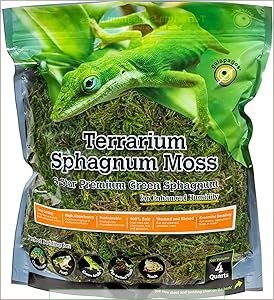
Galapagos Natural Sphagnum Moss is like the superhero of substrates for a ball python’s habitat.
It’s perfect for regulating humidity, making it especially helpful during shedding cycles. This natural moss is soft, non-toxic, and long-lasting, so you won’t need to replace it as often.
Plus, it holds moisture without creating a mess, which is great for both your snake and your cleaning routine.
Think of it as the cozy, humid comfort zone your python needs to feel secure and stress-free!
Best For: Ball python owners looking for a natural, long-lasting substrate that supports humidity control and shedding.
- Excellent for maintaining humidity, especially during shedding cycles.
- Soft, non-toxic, and safe for reptiles.
- Long-lasting and low maintenance.
- Can be messy if over-soaked with water.
- Requires occasional replacement to maintain cleanliness.
- Pricing may be higher than synthetic alternatives.
6. Forest Floor Animal Bedding Substrate
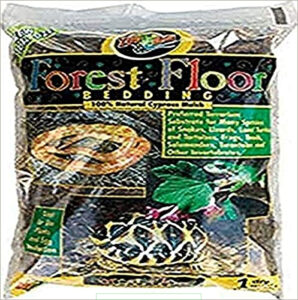
For a natural “forest floor” vibe, Forest Floor Animal Bedding Substrate is spot-on for your Ball Python.
It is made from cypress mulch, it holds moisture beautifully, helping maintain that essential 50-60% humidity.
Your python will appreciate the softer texture and better hydration, especially during shedding.
However, spotting waste might feel like playing hide-and-seek—trust your nose when cleaning!
Add water occasionally to keep it fresh, and remember, it’s not ideal for feeding pythons, but overall, it’s a keeper for humidity-loving reptiles.
Best For: Reptile owners, especially ball python keepers, seeking a substrate that retains humidity and provides a natural look.
- Maintains excellent humidity for shedding and overall health.
- Provides a soft, natural environment.
- Long-lasting and cost-effective compared to pet store substrates.
- Difficult to spot clean due to its texture and color.
- Waste can be hard to detect without a smell test.
- Not suitable for in-enclosure feeding due to potential choking hazards.
7. Flukers Repta Vines Pothos Reptile Terrarium Decor
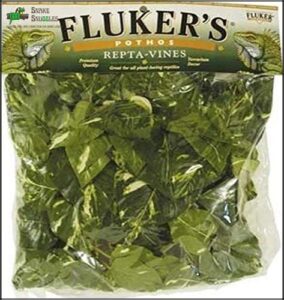
Fluker’s Repta Vines Pothos decor is a smart addition to your ball python’s enclosure.
These six-foot-long, nontoxic vines mimic nature, offering climbing and hiding opportunities your snake will love.
Customizable with suction cups, they’re easy to place and maintain, while some users report suction cup issues or mild fading, regular upkeep keeps them looking great.
Use these vines as enrichment to reduce stress and encourage natural behaviors.
For larger enclosures, consider grabbing multiple packs to create a lush, inviting environment.
Best For: Reptile or amphibian owners looking to enhance their pet’s enclosure with lifelike, customizable decor for climbing and hiding.
- Nontoxic, easy-to-clean polyethylene material.
- Lifelike, natural appearance encourages enrichment.
- Adjustable length with suction cups for versatile placement.
- Suction cups may not hold securely in some setups.
- Potential color fading over time with use.
- Leaves may require frequent cleaning if soiled by pets.
Setting Up Ideal Environment
Creating the perfect environment for your ball python means balancing temperature, humidity, and lighting to mimic their natural habitat.
With proper setup, you’ll keep your snake healthy and happy, and maybe even thinking it’s back in the African savanna—minus the predators!
Temperature Gradient and Humidity
After choosing a great substrate, focus on creating a temperature gradient with reliable heat sources.
Keep the warm side at 90-95°F and cool at 75-80°F for ideal ball python temperature zones.
Monitor ball python humidity levels at 50-60% using moisture-friendly substrates and misting.
Proper ventilation systems prevent mold while humidity control systems maintain steady moisture levels, especially during shedding.
Lighting and Photoperiod Cycle
Getting your UVB lighting and day-night cycle right is essential for your ball python’s rhythm.
Stick to a 12-hour photoperiod cycle—on during the day, off at night.
Use low-strength UVB lights for visibility, not vitamin D.
Avoid harsh thermal lighting; they prefer subtlety.
Photoperiod control mimics nature, keeping your python content and perfectly in tune with its environment!
Water and Humidity Maintenance
Maintaining proper humidity levels is essential for your ball python’s health.
Aim for 50-60% daily and up to 80% during shedding.
Use a hygrometer to monitor humidity control, and try misting systems or humidity hides with moss for stability.
A larger water dish can boost evaporation rates, but if excess occurs, increase ventilation for balance.
Accurate humidity readings rely on a reliable ball python hygrometer to maintain ideal conditions with proper humidity levels.
Hides and Climbing Opportunities
Ball pythons love cozy hide boxes and climbing opportunities.
Place at least two hides—one on the warm side, one on the cool. Use rock formations or cave systems for added security.
Ball python branches encourage natural climbing behavior, while secure branch arrangements reduce stress. Skip reptile carpet—it’s impractical.
A good setup balances comfort, activity, and snake safety. Providing proper snake housing hides is essential for creating a stress-free environment.
Maintaining Healthy Habitat
Keeping your ball python’s habitat healthy isn’t complicated, but it does take consistent effort.
By monitoring temperature and humidity, cleaning regularly, and adding enrichment, you’ll guarantee your snake thrives in a safe and stimulating environment.
Regular Cleaning and Maintenance
A healthy ball python habitat depends on consistent upkeep.
Spot-clean daily by removing waste and checking humidity control. Schedule weekly cleaning for water bowl scrubbing and substrate replacement of soiled areas.
Monthly cleaning involves tank maintenance, deep cleaning decorations, and changing all substrate.
Think of this routine like sprucing up your snake’s home—it keeps them happy and stress-free, which is crucial for their well-being, and following this routine is essential.
Monitoring Temperature and Humidity
Keeping your ball python’s habitat cozy is all about dialing in temperature control and humidity levels.
Use a digital thermometer for accurate readings and an infrared thermometer for spot checks. A humidity range of 50-60% works best, while ideal temperatures span a gradient of 75-95°F.
Regularly calibrate thermometers and hygrometers to assure accuracy—it’s a science, not guesswork! Maintaining a proper temperature gradient is essential for the health and well-being of your snake.
- Tools to use: Digital thermometer, hygrometer, infrared thermometer.
- Ideal range: 50-60% humidity; 75-95°F temperature gradient.
- Test weekly: Calibrate devices for accuracy.
- Humid strategies: Misting or a water bowl increases moisture.
Providing Enrichment and Stimulation
Give your ball python a habitat that feels like home with Environmental Toys and Textured Surfaces.
Hide Boxes offer privacy, while Climbing Structures add exercise and fun.
Sensory Stimulation, like varied layouts or decor, prevents boredom.
Ball python enrichment doesn’t break the bank—get creative with safe DIY options to keep them exploring.
Good reptile care means a happier, healthier snake.
Signs of Illness and Veterinary Care
If your python skips meals or seems off, don’t ignore it.
Watch for signs like respiratory issues, skin problems, or feeding difficulties.
Regular veterinary checks are your safety net for catching hidden health symptoms and ensuring animal welfare.
Keep an eye on yearly health checks—they’re like your snake’s version of a wellness spa, minus the cucumber slices.
Frequently Asked Questions (FAQs)
How Often Should I Clean My Ball Python’s Enclosure?
Spot clean the enclosure daily to remove waste, shed skin, or leftover food.
Perform a deep clean with substrate replacement monthly.
A tidy habitat keeps your ball python happier and healthier—everyone appreciates a clean home!
What is the Best Way to Feed My Ball Python?
To feed your ball python, offer appropriately-sized, pre-killed rodents using tongs for safety.
Avoid live prey—it’s risky.
Feed at night to match their natural activity.
Watch them swallow—it’s fascinating, like nature’s slow-motion magic show!
How Often Should I Handle My Ball Python?
Handle your ball python 1-2 times a week, for short, calm sessions.
Avoid stressing it out by handling after feeding or during shedding.
Build trust gradually—think of it as bonding time, snake style!
What Plants Are Safe to Have in a Ball Python Enclosure?
Think of plants as décor with a purpose—safe options include pothos, snake plants, or bromeliads.
They’re non-toxic, low-maintenance, and great at boosting humidity.
Just avoid sharp edges or sappy plants like ivy or aloe.
Are Ball Pythons Vocal?
Ball pythons aren’t vocal, but they sometimes hiss if startled or stressed.
This sound isn’t threatening—just a way to say, “Give me space!”
It’s their silent charm and stealth, not noise, that steals hearts.
What is the best habitat for a ball python?
Imagine creating a safe, cozy oasis—a 4’x2’x2’ enclosure with warm (90°F) and cool (75°F) zones, 55% humidity, secure hides, and enriching décor.
Pair this with proper ventilation, lighting, and substrate for perfection.
Can you leave a heat lamp on 24/7 for ball python?
You shouldn’t leave a heat lamp on 24/7 for a ball python.
It can disrupt their natural day-night cycle.
Use a timer or thermostat to maintain proper temperatures and create a healthy environment.
What do ball pythons like in their tank?
Provide hides for security, climbing branches for exercise, and a cozy substrate like coconut fiber.
Add plants for enrichment, maintain proper temperature zones, and maintain 50-60% humidity.
They appreciate a calm, cluttered habitat.
What not to do with a ball python?
Don’t overhandle your python—it’s like forcing small talk with an introvert.
Avoid using cedar shavings, as they’re toxic.
Skip live feeding to prevent injury, and never neglect proper temperature, humidity, or enclosure security.
What plants are safe for ball pythons?
Safe plants for ball pythons include pothos, snake plants, and spider plants.
Stick with non-toxic varieties, as some can harm your snake.
Avoid sharp or spiky options—they’re not fans of surprise “plant pokes”!
Conclusion
Just like building a castle for a king, crafting the ultimate ball python habitat takes thoughtful planning and care.
With proper temperature gradients, ideal humidity levels, and cozy hides, your snake will thrive in its environment.
Pay attention to substrate choices, consistent lighting, and fresh water to achieve a setup that mimics their natural needs.
Regular maintenance is key, so keep everything clean and functional, and follow these ball python habitat tips, and you’ll have one happy, healthy royal reptile with a well-planned environment.
- https://www.turtletimes.com/ball-python-enclosure/
- https://www.reddit.com/r/snakes/comments/3fx9b4/tank_size_for_a_ball_python/
- https://reptifiles.com/ball-python-care-guide/ball-python-humidity-temperatures/
- https://www.zenhabitats.com/blogs/reptile-care-sheets-resources/ball-python-complete-substrate-guide
- https://www.amazon.com/ball-python-hide/s?k=ball+python+hide

